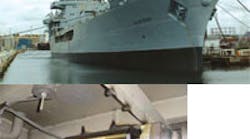Marine vessels are especially prone to transmitting noise and vibration due to extensive use of steel and large, flat surfaces that propagate noise and vibration. A hydraulic surge suppressor, left, can reduce hydraulic system-borne noise and vibration by reducing pressure surges at their source.
Any form of power transmission generates noise, and hydraulics is no exception. However, noise generation can be especially problematic on shipboard hydraulic systems. That’s because the metal structure of boats and ships lends itself to transmitting noise and vibration throughout the vessel. In fact, some structures can transform mechanical vibration into airborne noise and even amplify noise and vibration.
A builder of hydraulic cranes and winches for use on ships revealed that a hydraulic surge suppressor from Wilkes & McLean Ltd., Schaumburg, Ill., helped contribute to an impressive reduction in noise generated by the equipment’s hydraulics system. Steve Kopfman, of Wilkes & McLean, says that prior to the reduction, the hydraulic system could be heard 14 miles away when the cranes were running on a ship. The noise and vibration were so bad that they could be felt in the feet of people standing on the deck.
Kopfman points out that hydraulic pulsations and shock can lead to premature component failure. They can also increase leakage because repeated pulsations can force fluid through threads of fittings and other tight-fitting surfaces that would otherwise contain fluid not subjected to pulsations.
Noise generated by the crane ranged from 105 to 108 dBA. Designers then took several steps to reduce the noise and vibration. The hydraulic system’s gear pump was replaced with a vane pump of larger size. Vane pumps inherently run quieter than gear pumps. Plus, the larger size allows the pump to run at a lower speed, which further reduces noise generation.
Piping sizes were also increased to reduce fluid velocity. Furthermore, cushioned mounting clamps were provided for long runs of tubing to reduce the transmission on vibration from the tubing to the ship’s structure.
Another modification involved installing a hydraulic noise suppressor, offered by Wilkes & McLean. The noise suppressor installs on the hydraulic pump discharge line and uses baffles, bladders, and springs to damp pressure and flow surges within the hydraulic fluid. By doing so, less noise is generated and transmitted by the hydraulic system.
Kopfman says that such design modifications normally might reduce noise by 4 to 8 dBA in machinery on the factory floor. In this case, however, noise generation dropped dramatically, to 83 to 86 dBA. He adds that after implementing the design modifications, the hydraulic system is so quiet that people can actually hear the ship’s diesel engines running, which wasn’t the case when the hydraulic system was so noisy.
For more information, call Steve Kopfman at (847) 534-2000, e-mail [email protected], or visit www.wilkesandmclean.com.


